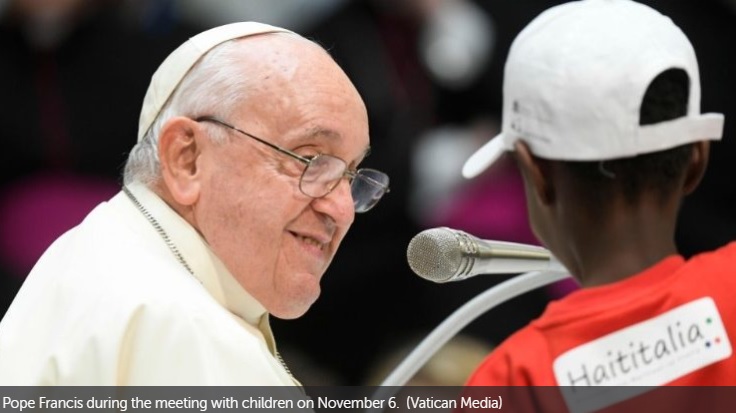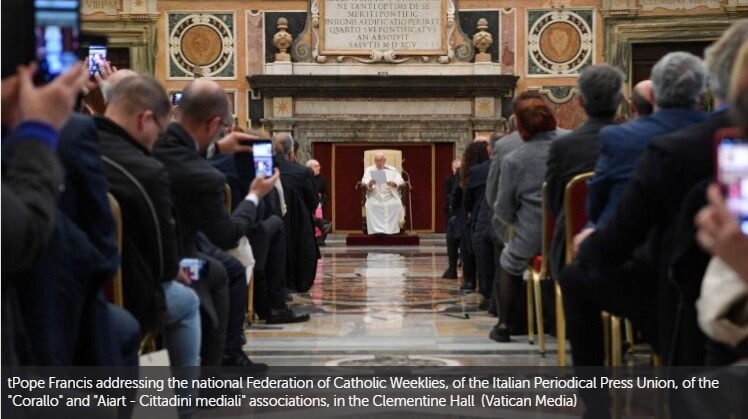In his message for the 58th World Day of Social…

Theological significance of Act of Consecration explained
Pope Francis consecrates Russia and Ukraine to the Immaculate Heart of Mary on Friday afternoon. Father Stefano Cecchin, OFM, President of the International Pontifical Marian Academy, says “Peace is always born from God and therefore, conforming to the heart of She who loves Him immensely.”
As children turn to their Mother, so mankind entrusts itself to Mary, Queen of Peace, in the midst of the storm, of a war unleashed a month ago between Russia and Ukraine.
“To you, we consecrate the future of the whole human family, the needs and expectations of every people, the anxieties and hopes of the world.”
These words of the Act of Consecration of Russia and Ukraine to the Immaculate Heart of Mary resound Friday at around 6:30pm, local time, in St Peter’s Basilica, when the Pope presides over the Rite of Reconciliation with individual confession and absolution.
The same Act of Consecration is being prayed Friday by all the bishops of the world. At Fatima, Cardinal Konrad Krajewski, the papal almoner, performs the act as Pope Francis’ special envoy.
Conforming to the heart of Mary
Pope Francis’ decision to consecrate Russia, Ukraine and the whole of humanity to the Immaculate Heart of Mary is in keeping with the tradition of the Church’s Magisterium, which has always looked to Our Lady as the one to whom one can entrust oneself in times of trial.
In an interview with Vatican News, Mariologist Father Stefano Cecchin, OFM, President of the International Pontifical Marian Academy, underlined the theological significance of this consecration.
“To find peace we must conform to the heart of Mary, a heart that loves immensely,” he said. In October 2020, when meeting the teachers and students of the Marianum Pontifical Theological Faculty in Rome, the Pope invited them to remain “always attentive to the signs of the Marian times that run through our era.”
According to Father Cecchin, Pope Francis’ decision to renew this act of consecration at this historic moment stems precisely from this attention: “When there are wars in a family, one entrusts oneself to the Mother.”
Please find below the interview with Father Stefano Cecchin ofm, Mariologist
Q: Father Cecchin, as a Mariologist, how did you welcome the Pope’s decision?
I am leaving for Fatima, where a conference is being held on the consecration of Portugal to the Immaculate Conception, which took place in 1931. It was then the first nation in the world to be consecrated to the Immaculate Heart of Mary. In preparing my report, I retraced the Church’s journey in the “Land of Mary”, as the country of Portugal is called. I realised how this presence, in all the difficult moments of Portugal’s history, culminated in the apparitions of Fatima. And it was precisely Fatima that gave us the image of Mary being concerned about the situation in Europe at that time. We were in 1917, there was the Russian revolution, the First World War, and God continued to take care of us through Mary, who, in the apparitions at Fatima, asked for the consecration of Russia. I want to say that if we look carefully for the “signs of the Marian times”, as Pope Francis has invited us to do, we will also find them in the present historical moment. So, I found the Pope’s decision to renew this consecration and thus to entrust the two nations at war, Russia and Ukraine, to “Mother” truly wonderful. Pope Francis continues to tell us that the common house is a woman, and is like Mary, that the Church is like Mary and is Mother. We know very well that in a family when children do not get along and there are problems, the mother is the one who tends to bring peace. This act of entrustment is the result of the Pope’s intuition and we thank him very much.
Q: What is the theological significance of this consecration?
The Heart of Mary is the heart of God. We must think that Mary is the one who shared her only Son with the Father. That Son was loved immensely by the Father and the Mother, as John Paul II and Paul VI and the whole tradition have reminded us. Mary opened up for us the way to love, who corresponded, more than any other creature, to God’s immense love. So we are all called to conform ourselves to this Heart in order to be able to love Jesus in others. We are convinced that true peace does not come from the United Nations, from weapons, or from the politics of States, but only from God. Therefore, if we want to create peace, we must conform our hearts to the one who loved God and who loves the Church and our brothers and sisters, that is, to Mary. Therefore, this is the Immaculate Heart of Mary: a heart that loves immensely, giving itself to all of us. Therefore, if we really want to create peace, we must start from our hearts conformed to the Immaculate Heart of Mary.
Q: Pope Francis has invited the bishops of the world and their priests to join him in this Act of Consecration and entrustment. Why?
It seems to me that this choice is linked to the concept of synodality that Pope Francis continues to reiterate. The Pope represents the Church, the sense of unity, but unity with the Church and in the Church, which is – as he calls it – our common home. So we are not saved alone, as Pope Francis reminded us in Fratelli Tutti and always together we must ask God for the salvation of the world. “Where two or three are gathered in my name, I will be in the midst of them,” the Gospel reminds us, and Pope Francis emphasises that the journey of saving the world we must make together, not alone. This is why at this time the whole Church must be united, as in a great Synod, a great Council, in which God is asked to intervene.
Q: The history of the Church tells us that there have been various acts of consecration to the Immaculate Heart of Mary, made by Pope Francis’ predecessors: Pius XII, Paul VI and John Paul II. How can we place the Pope’s choice in the context of this tradition?
For us, it is very important that the Magisterium of the Church has always, throughout history, looked to Mary as the one who is the image of the unity of the Church, who takes care of the Church, who, in difficult moments, we must always invoke to help us find the solution. The most beautiful Marian icon, for me, is that of Mary showing us the way: Our Lady Hodigitria, the Virgin who shows us the way to Jesus. The Church with her wisdom enlightened by the Holy Spirit thus continues to reaffirm, as did also Vatican II, that Mary is a sign of sure hope. Let us remember that in the history of the Church, in the most difficult moments the name of Mary has always been invoked, as the pontifical magisterium reminds us. So Pope Francis is in continuity with the teaching of the Church.
Q: Why did the Pope want one of his envoys, Cardinal Krajewski, to make the same gesture at the Shrine of Fatima?
The apparitions of Fatima should be seen in the context of the path taken by Portugal. In the 17th century, the King of Portugal was the first to consecrate himself to the Immaculate Conception, even removing his crown and placing it on the head of the Immaculate Conception. Since then, the Kings of Portugal have never worn the crown, leaving this privilege to the Immaculate Conception. So, we are talking about a land where Mary has always shown her care and help in the most difficult moments. Fatima, therefore, becomes the apex of this manifestation which then went beyond the borders of Portugal to become a reality, therefore an apparition, which is valid for the whole world. So, it is not just a question of entrusting Russia and Ukraine to Mary’s heart, but everything that is injustice, that is against the right of the human person, that is mafia behaviour. All these realities we want to transform together through Mary to make a better world.
SOURCE: Vatican News by Fabio Colagrande and Benedetta Capelli




This Post Has 0 Comments